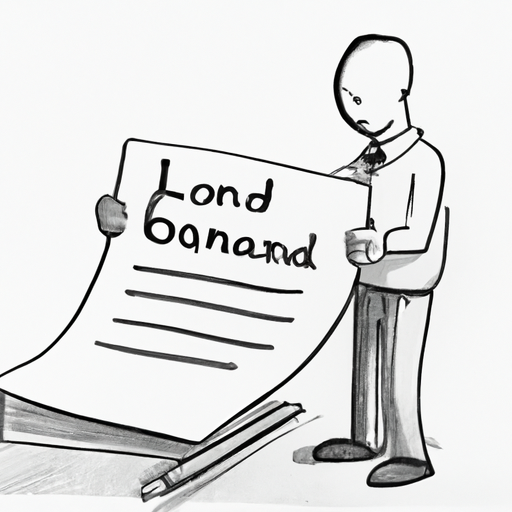The Loan Estimate is an important document when getting a mortgage loan. It provides detailed information about loan terms, payments, costs, and features. It’s crucial to consider factors beyond just the interest rate, such as the APR and loan term. Hidden fees should be uncovered and the fine print should be carefully reviewed to make an informed decision when comparing loan estimates from different lenders.
When it comes to obtaining a loan, whether it’s for a mortgage, car, or personal use, understanding the terms and costs associated with borrowing is crucial. One document that plays a significant role in this process is the Loan Estimate, also known as the Good Faith Estimate. This document provides borrowers with a breakdown of the costs and terms of their loan, allowing them to make informed decisions. In this article, we will delve into the various components of a Loan Estimate, decoding its key elements. Additionally, we will explore the importance of comparing Loan Estimates from different lenders to unveil the true cost of borrowing. Furthermore, we will discuss how to identify hidden fees and differences in Loan Estimates. Lastly, we will provide tips for accurately assessing Loan Estimates, including navigating the fine print. By the end of this article, readers will feel equipped to confidently read and compare Loan Estimates, ensuring they make the best borrowing decision for their financial needs.
- 1. Understanding the Loan Estimate: Decoding the Key Components
- 2. Comparing Loan Estimates: Unveiling the True Cost of Borrowing
- 3. Unveiling Hidden Fees: Spotting Differences in Loan Estimates
- 4. Navigating the Fine Print: Tips for Accurately Assessing Loan Estimates
1. Understanding the Loan Estimate: Decoding the Key Components

Understanding the Loan Estimate: Decoding the Key Components
When you are in the process of obtaining a mortgage loan, one of the most important documents you will encounter is the Loan Estimate, also known as the Good Faith Estimate. This document provides you with detailed information about the loan terms, estimated closing costs, and other important details. To make an informed decision and compare loan offers from different lenders effectively, it is crucial to understand the key components of the Loan Estimate. Here are the main elements you need to decode:
1. Loan terms: This section outlines the basic details of the loan, including the loan amount, interest rate, and loan term. It is essential to compare these elements across different loan offers to determine which lender is offering the most favorable terms for your specific needs.
2. Projected monthly payments: This section breaks down the estimated monthly payment for your mortgage, including principal and interest, mortgage insurance (if applicable), property taxes, and homeowner’s insurance. By comparing these figures across lenders, you can assess the affordability of each loan and choose the one that best fits your budget.
3. Closing costs: The Loan Estimate provides an estimate of the closing costs you will have to pay when finalizing the loan. These costs include appraisal fees, title insurance, lender fees, and prepaid items such as property taxes and homeowner’s insurance. By carefully reviewing this section, you can compare the costs associated with each loan offer and consider the overall financial impact.
4. Loan features: This section outlines any special features or terms associated with the loan, such as prepayment penalties or adjustable interest rates. Understanding these features is crucial to ensure that you are comfortable with the terms and potential risks associated with each loan offer.
5. Other considerations: The Loan Estimate may also include additional information that is specific to your loan, such as whether the loan can be assumed by another borrower or if there are any penalties for late payments. Paying attention to these details will help you make an informed decision and compare
2. Comparing Loan Estimates: Unveiling the True Cost of Borrowing

When it comes to comparing loan estimates from different lenders, it’s important to remember that the interest rate alone should not be the sole determining factor. While the interest rate certainly affects the overall cost of borrowing, there are other fees and charges that can significantly impact the true cost of the loan.
One of the key elements to compare across lenders is the annual percentage rate (APR). The APR reflects the total cost of the loan, including both the interest rate and any additional fees or charges. By comparing the APRs of different loan estimates, borrowers can get a clearer picture of the true cost of borrowing and make an informed decision.
Another factor to consider is the loan term. While a longer loan term may result in lower monthly payments, it can also mean paying more in interest over the life of the loan. Comparing loan estimates with different loan terms can help borrowers assess the trade-off between lower monthly payments and the overall cost of the loan.
In addition to the APR and loan term, it’s crucial to carefully review the itemized fees and charges listed in the loan estimate. These may include origination fees, appraisal fees, closing costs, and other expenses associated with the loan. While some of these fees may be negotiable, it’s essential to factor them into the overall cost comparison.
Furthermore, borrowers should pay attention to any prepayment penalties or balloon payments mentioned in the loan estimate. Prepayment penalties can impose significant costs if borrowers choose to pay off their loan early, while balloon payments require borrowers to make a large lump sum payment at the end of the loan term. Evaluating these aspects is crucial to understanding the true cost and potential risks associated with the loan.
When comparing loan estimates, it’s also beneficial to seek clarification from lenders about any confusing or unclear terms. By asking questions and seeking additional information, borrowers can ensure they have a complete understanding of each loan estimate and make an accurate comparison.
In conclusion, comparing loan estimates involves more than just looking at the interest rate. Borrow
3. Unveiling Hidden Fees: Spotting Differences in Loan Estimates

When comparing loan estimates from different lenders, it is crucial to unveil any hidden fees that may be present. Hidden fees can significantly impact the overall cost of a loan and can make a significant difference in the long run. Here are some key points to consider when spotting differences in loan estimates and uncovering hidden fees:
1. Understand the breakdown of fees: Loan estimates typically include an itemized breakdown of various fees associated with the loan. Take the time to carefully review and understand each fee listed. Look for any discrepancies or fees that seem unusual or excessive. Common fees to watch out for include application fees, origination fees, processing fees, underwriting fees, and appraisal fees.
2. Pay attention to the APR: The annual percentage rate (APR) is an essential factor to consider when comparing loan estimates. The APR reflects the true cost of the loan, including both the interest rate and any associated fees. By comparing the APRs of different loan estimates, you can get a better idea of which lender is offering the most favorable terms.
3. Scrutinize third-party fees: In addition to the fees charged by the lender, there may be third-party fees involved in the loan process. These fees can include charges for services such as title insurance, escrow services, and attorney fees. Make sure to carefully review these third-party fees and compare them across different loan estimates. While lenders have limited control over third-party fees, they can vary significantly between lenders, impacting the overall cost of the loan.
4. Look for fee waivers or reductions: Some lenders may offer fee waivers or reductions as part of their loan estimates. These can help offset some of the costs associated with the loan. Look for any mention of fee waivers or reductions in the loan estimate and consider their impact on the overall cost. However, keep in mind that fee waivers or reductions should not be the sole factor in choosing a lender. It is essential to consider the overall terms and conditions of the loan as well.
5
4. Navigating the Fine Print: Tips for Accurately Assessing Loan Estimates

Navigating the fine print of a loan estimate is crucial for accurately assessing the loan terms and comparing them across lenders. Often, borrowers tend to focus solely on the key figures presented in the estimate, such as the interest rate and monthly payment, while overlooking the details buried in the fine print. However, these details can have a significant impact on the overall cost and terms of the loan. Here are some tips for effectively navigating the fine print of a loan estimate:
1. Understand the terminology: Loan estimates often contain technical terms and industry jargon that may be unfamiliar to borrowers. Take the time to research and understand these terms to ensure you have a clear understanding of what you’re being offered. If there are any terms or concepts you don’t understand, don’t hesitate to reach out to the lender for clarification.
2. Scrutinize the loan terms: Pay close attention to the loan terms outlined in the fine print. Look for important details such as the loan duration, whether the interest rate is fixed or adjustable, and any penalties or fees associated with early repayment or late payments. These terms can significantly impact the total cost of the loan and your ability to manage it effectively.
3. Compare fees and closing costs: The fine print of a loan estimate provides a breakdown of the various fees and closing costs associated with the loan. Carefully review these costs and compare them across different lenders. Look out for any hidden fees or excessive charges that may inflate the overall cost of the loan. Remember, even seemingly small differences in fees can add up to significant amounts over the life of the loan.
4. Consider the APR: While the interest rate is an important factor to consider, it may not provide a complete picture of the loan’s cost. The annual percentage rate (APR), which factors in both the interest rate and other loan costs, gives a more accurate representation of the loan’s true cost. Compare the APRs of different loan estimates to determine which lender is offering the most favorable terms.
In conclusion, understanding and comparing loan estimates is essential for borrowers who want to make informed decisions about their borrowing options. By decoding the key components of a loan estimate, borrowers can gain a clear understanding of the costs and terms associated with their loan. Additionally, comparing loan estimates across lenders allows borrowers to uncover the true cost of borrowing and identify any hidden fees or discrepancies. Navigating the fine print and paying attention to the details outlined in the loan estimate is crucial for accurately assessing the overall value of a loan. Armed with this knowledge, borrowers can confidently choose the lender and loan that best fits their needs and financial goals.

